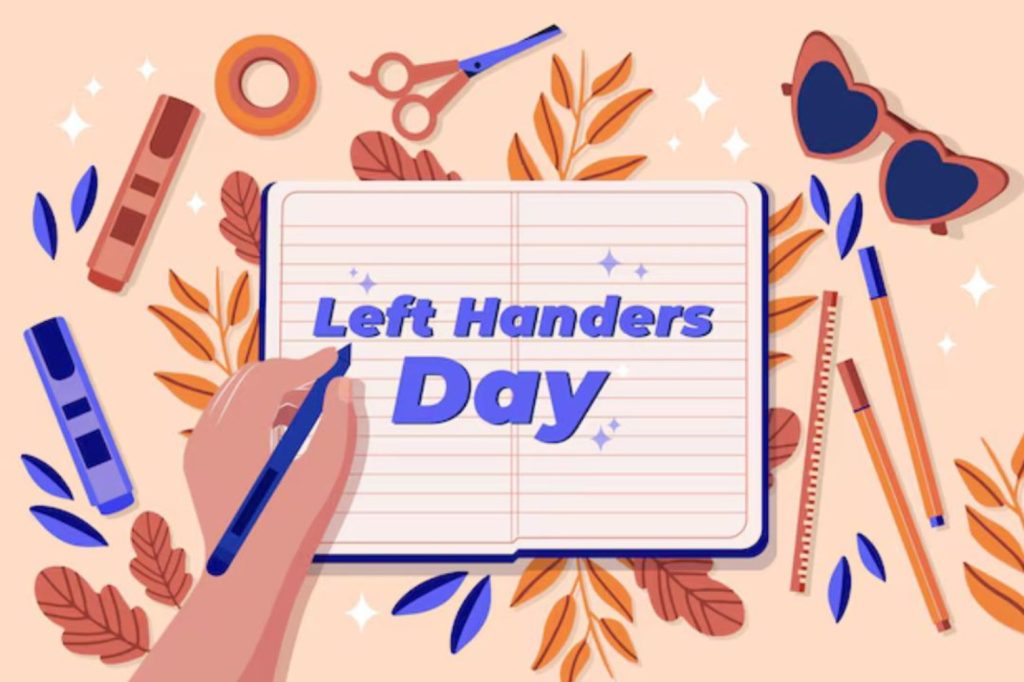International Lefthanders Day is a day to recognize, celebrate, and support people who are naturally left-handed. Observed every year on 13th August, it raises awareness about the uniqueness of left-handed individuals, their achievements, and the challenges they face in a world mainly designed for right-handed people.
What is International Lefthanders Day?
International Lefthanders Day is an annual event celebrated worldwide to promote awareness about left-handed individuals. It aims to:
- Appreciate their unique skills.
- Highlight the need for more left-hand-friendly tools.
- Break myths and negative beliefs about left-handedness.
Only around 10% of the world’s population is left-handed, making them a special minority with their own strengths.
History of International Lefthanders Day
The first International Lefthanders Day was celebrated on 13th August 1976 by Dean R. Campbell, founder of Left-Handers International, Inc..
In earlier centuries, left-handedness was misunderstood. Some cultures considered it unlucky, while schools often forced children to switch to their right hand for writing. This practice caused discomfort and affected learning.
The introduction of this day brought global attention to the fact that left-handedness is natural and not a defect. Today, it is a day of pride for left-handers around the world.
Importance of International Lefthanders Day
1. Promoting Inclusivity
International Lefthanders Day reminds us that everyday items—from scissors to desks—should be designed for both left- and right-hand users.
2. Educating Society
Many right-handed people are unaware of the difficulties faced by left-handers. This day spreads awareness so that schools, workplaces, and manufacturers can make changes.
3. Celebrating Achievements
From sports to science, left-handed people have made remarkable contributions. This day celebrates their role in shaping our world.

Interesting Facts About International Lefthanders Day
- Around 1 in 10 people are left-handed.
- Men are slightly more likely to be left-handed than women.
- Left-handers are sometimes called southpaws, especially in sports.
- Studies suggest left-handers may have better spatial skills and creativity.
- August 13 was chosen for International Lefthanders Day partly as a fun reference to the number 13, often linked to myths, to turn it into something positive.
Famous Left-Handed People
On International Lefthanders Day, we also remember famous left-handed personalities:
- Albert Einstein – Renowned physicist.
- Leonardo da Vinci – Great artist and inventor.
- Mahatma Gandhi – Freedom leader of India.
- Barack Obama – Former US President.
- Sachin Tendulkar – Legendary cricketer.
- Bill Gates – Co-founder of Microsoft.
These examples show that left-handedness is linked with talent, intelligence, and leadership.

Challenges Faced by Left-Handers
Even today, left-handers encounter challenges:
- Most scissors, notebooks, and rulers are designed for right-handers.
- Desks in classrooms may be uncomfortable for left-handed writing.
- Musical instruments like guitars often require special versions.
- Ink smudging while writing is a common issue.
International Lefthanders Day encourages creating equal opportunities for both left- and right-handed people.
How International Lefthanders Day is Celebrated
1. Awareness Campaigns
Schools and workplaces organize events to share stories about left-handed people.
2. Right-Handers Try Left-Hand Tasks
Fun activities where right-handed individuals try writing, drawing, or using tools with their left hand to understand the challenges.
3. Social Media Participation
People share their photos, facts, and experiences using hashtags like #LefthandersDay.
4. Special Left-Handed Products
Shops offer discounts on left-handed tools like scissors, stationery, and kitchen utensils.
The Science Behind Being Left-Handed
International Lefthanders Day is also a reminder that left-handedness is a result of how the brain works.
- The left hemisphere controls the right hand and is linked with logical thinking.
- The right hemisphere controls the left hand and is linked with creativity.
In left-handed people, the brain’s wiring often makes the right hemisphere more active for movement.
How to Support Left-Handers
On International Lefthanders Day, you can:
- Give left-hand-friendly stationery and tools.
- Avoid forcing children to switch hands.
- Make seating arrangements comfortable for both left- and right-handed people.
- Appreciate their unique talents.
Conclusion
International Lefthanders Day is much more than just a date on the calendar—it is a worldwide reminder that diversity makes our world stronger and more interesting. This day celebrates the unique qualities of left-handed individuals, from their creativity and problem-solving skills to their valuable contributions in every field of life, including science, art, sports, and leadership.
By observing this day, we are encouraged to look beyond differences in hand preference and focus on building a society that offers equal opportunities for all. It challenges outdated stereotypes, promotes understanding, and inspires manufacturers, educators, and communities to design tools, systems, and spaces that are comfortable for everyone, regardless of whether they use their left or right hand.
In the end, International Lefthanders Day sends a powerful message: every person’s skills, talents, and perspectives are important. Respecting and embracing these differences not only supports left-handed individuals but also creates a more inclusive, innovative, and compassionate world for future generations.
FAQs on International Lefthanders Day
Q1. When is International Lefthanders Day celebrated?
It is celebrated on 13th August every year.
Q2. Why do we celebrate International Lefthanders Day?
To raise awareness about the challenges faced by left-handers, promote equality, and celebrate their contributions.
Q3. How many people in the world are left-handed?
Around 10% of the global population.
Q4. Who started International Lefthanders Day?
Dean R. Campbell in 1976.
Q5. Is being left-handed rare?
Yes, it is less common than right-handedness, making left-handers a unique group.



